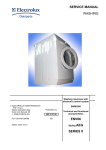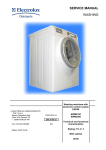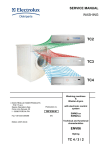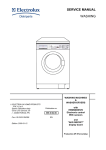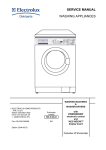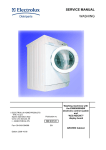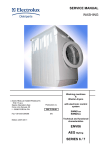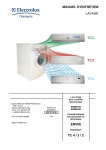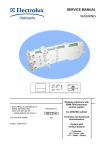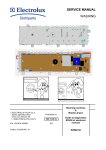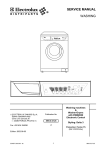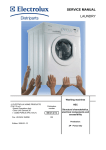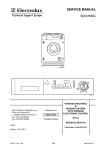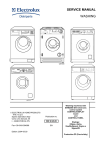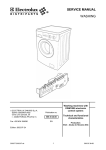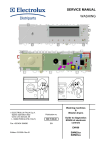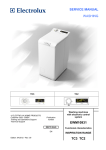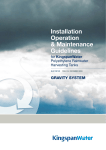Download Electrolux TC1 Service manual
Transcript
SERVICE MANUAL WASHING Washing machines with electronic control system © ELECTROLUX HOME PRODUCTS ITALY S.p.A. Spares Operations Italy Corso Lino Zanussi, 30 I - 33080 PORCIA /PN Fax +39 0434 394096 Edition: 2007-02-13 EWM3500 Publication no. 599 38 61-92 Technical and functional characteristics EN STYLING: TC1 With cabinet ICON SOI/DT 2007-02 dmm 2/66 599 38 61-92 CONTENTS 1 2 3 4 5 6 7 8 9 Purpose of this manual ....................................................................................................................................5 PRECAUTIONS ...............................................................................................................................................5 2.1 During the delivery....................................................................................................................................6 2.2 During the reparation ................................................................................................................................6 TC1 ..................................................................................................................................................................7 3.1 GENERAL CHARACTERISTICS..............................................................................................................7 3.2 CONTROL PANEL ...................................................................................................................................8 3.2.1 Styling TC1 ........................................................................................................................................8 Summary table of the main areas and their contents ......................................................................................9 4.1.1 First switching on.............................................................................................................................10 4.2 Configuration of control panel.................................................................................................................11 4.2.1 Programme selector (S1) ................................................................................................................11 4.2.2 BUTTONS AND LCD.......................................................................................................................12 4.2.3 Time DRIVEN ..................................................................................................................................14 4.2.4 Washing phases ..............................................................................................................................15 4.2.5 Control of the options set during the cycle ......................................................................................16 4.2.6 Washing cycle in pause...................................................................................................................16 4.2.7 Stop or cancelation of a programme ...............................................................................................17 4.2.8 End of cycle .....................................................................................................................................17 4.2.8.1 Stand-by ...................................................................................................................................17 4.2.9 Child lock .........................................................................................................................................18 4.2.10 Memory............................................................................................................................................19 4.2.11 Wash Guide.....................................................................................................................................20 4.2.11.1 Temperature Guide ..................................................................................................................20 4.2.11.2 Spin guide ................................................................................................................................21 4.2.11.3 Options guide ...........................................................................................................................22 4.2.11.4 Stain guide ...............................................................................................................................23 4.2.11.5 Demo ........................................................................................................................................24 4.2.12 Settings............................................................................................................................................25 4.2.12.1 Language .................................................................................................................................25 4.2.12.2 Volume .....................................................................................................................................26 4.2.12.3 Time..........................................................................................................................................27 4.2.12.4 Luminosity ................................................................................................................................28 4.2.12.5 Contrast....................................................................................................................................29 4.2.12.6 Resetting the settings...............................................................................................................30 4.2.12.7 Delayed start ............................................................................................................................31 DIAGNOSTIC SYSTEM.................................................................................................................................32 5.1 Access to diagnostic mode .....................................................................................................................32 5.2 Exiting diagnostic mode..........................................................................................................................32 5.3 Diagnostic phases ..................................................................................................................................33 5.3.1 Analysis of the LCD display during the diagnostic cycle .................................................................34 ALARMS ........................................................................................................................................................35 6.1 Displaying the alarms to the user ...........................................................................................................35 6.2 Reading the alarm codes........................................................................................................................36 6.2.1 Displaying the alarm ........................................................................................................................37 6.2.2 Examples of alarm display...............................................................................................................37 6.2.3 Operation of alarms during diagnostics...........................................................................................37 6.3 Rapid reading of alarm codes.................................................................................................................38 6.4 Cancelling the last alarm ........................................................................................................................38 6.5 Cancelling the memories ........................................................................................................................39 OPERATING TIME COUNTER .....................................................................................................................39 WASHING PROGRAMMES AND OPTIONS ................................................................................................40 8.1 Programmes ...........................................................................................................................................40 8.2 Options....................................................................................................................................................41 8.2.1 Compatibility between Options........................................................................................................43 8.3 Description of options .............................................................................................................................44 TECHNICAL CHARACTERISTICS................................................................................................................46 9.1 Control system memory..........................................................................................................................46 9.1.1 General structure of the memory system ........................................................................................46 9.1.2 FLASH .............................................................................................................................................46 9.1.3 RAM.................................................................................................................................................47 9.2 Door interlock..........................................................................................................................................48 9.2.1 Voltmetric interlock with PTC...........................................................................................................48 9.2.1.1 Operating principle ...................................................................................................................48 9.2.2 Instantaneous door interlock ...........................................................................................................49 SOI/DT 2007-02 dmm 3/66 599 38 61-92 9.2.2.1 Operating principle ...................................................................................................................49 9.2.2.2 Conditions required for opening the door.................................................................................49 9.2.2.3 Automatic unlock ......................................................................................................................49 9.3 Water fill system .....................................................................................................................................50 9.4 Analogue pressure switch of water level control in the tub ....................................................................50 9.5 Drain pump .............................................................................................................................................51 9.6 Recirculation pump (if featured)..............................................................................................................51 9.7 Heating....................................................................................................................................................52 9.8 Temperature sensor ...............................................................................................................................52 9.9 Three-phase asynchronous motor..........................................................................................................53 9.9.1 Power supply to motor.....................................................................................................................53 9.10 Anti-foam control system.....................................................................................................................54 9.11 FUCS ( Fast Unbalance Control System) ...........................................................................................55 9.12 Table of alarm codes...........................................................................................................................57 10 Diagram with THREE-PHASE ASYNCHRONOUS MOTOR .....................................................................60 11 ACCESSIBILITY.........................................................................................................................................62 11.1 To the electronic control system .........................................................................................................62 11.1.1 Work top ..........................................................................................................................................62 11.1.2 Control panel ...................................................................................................................................62 11.2 Door interlock ......................................................................................................................................64 11.3 New drain filter ....................................................................................................................................65 11.4 Inverter board ......................................................................................................................................66 SOI/DT 2007-02 dmm 4/66 599 38 61-92 1 Purpose of this manual The purpose of this manual is to provide service engineers who are already familiar with the repair procedures for traditional washing machines with information regarding appliances fitted with the ENV06 electronic control system and produced in Porcia (Italy). The characteristic of the ENV06 electronic control system is to use only an electronic pressure switch to check the various water levels in the tub (with the elimination of the mechanical pressure switches: anti-overflow, antiboiling, 1st-2nd level), and a new heater with two thermal fuses which interrupt if the temperature degree overcomes the values by which they are calibrated. The following are described: • • • • general characteristics control panel and washing programmes technical and functional characteristics access to the electronic control system For detailed information concerning hydraulic circuit, structural characteristics of the appliances and accessibility, please refer to Service Manual: • Publication no. 599 37 47-13 – washing machines with HEC cabinet. 2 PRECAUTIONS SOI/DT 2007-02 dmm Electrical appliances must be serviced only by qualified Service Engineers. Always remove the plug from the power socket before touching internal components. In case of replacement of the heater, replace it with one with the same characteristics in order not to compromise the safety of the appliance. Before laying down the appliance, always drain the water through the appropriate system placed near the drain filter. Do not lay down the appliance on the right side (electronic control side): some water could come out from the detergent drawer that would deposit on the electrical components with possible burnings. 5/66 599 38 61-92 2.1 During the delivery NEVER MOVE the appliance inclining it on the front side 2.2 During the reparation NEVER LAY DOWN THE APPLIANCE On the front side On the right side IT IS POSSIBLE TO LAY DOWN THE APPLIANCE On the left side SOI/DT 2007-02 dmm On the rear side 6/66 599 38 61-92 3 TC1 3.1 GENERAL CHARACTERISTICS The ENV060 electronic control system consists of two electronic boards. One integrates the power and control functions and the selector, the other the display function, where also the LCD display is connected. The PCB is mounted on a casing fitted to the control panel. Version TC1 Number of buttons Number of LEDs Programme selector Serial port Power supply Type of washing Rinsing system Motor Spin speed Anti-unbalancing system Water fill Detergent drawer Control of water level in the tub Door safety device Power of heating element Temperature control Board with loudspeaker Sensors SOI/DT 2007-02 dmm Max. 8 (5 options + 1 start/pause + 2 for time driven) Max. 2 + LCD display 15-21 positions with main switch (incorporated in the PCB ) DAAS-EAP communications protocol up to 115.200 baud 220/240V 50/60 Hz (configurable) Jet-system Jet-system Two-pole asynchronous, with three-phase tachometric generator (with Inverter) 600 ÷ 1800 g/’ FUCS 1 solenoid valve with 1 inlet – 2/3 outlets 3 compartments: prewash/stains, wash, conditioners 4 compartments: prewash/stains, wash, conditioners, bleach Electronic/analogue pressure switch Traditional (with PTC) Instantaneous 1950W with thermal fuses incorporated NTC sensor incorporated in the heater Board with emits some musical motifs Water fill gauge (flowmeter) Aqua control 7/66 599 38 61-92 3.2 CONTROL PANEL 3.2.1 Styling TC1 • • • • max. 8 buttons 15 or 21-position programme selector LEDs 2 LCD display • Disposition of LEDs and buttons SOI/DT 2007-02 dmm 8/66 599 38 61-92 4 Summary table of the main areas and their contents LOGO LANGUAGE SETTING MAIN INTERFACE TIME SETTING CYCLE DURATION SELECTION TEMPERATURE SELECTION SPIN SELECTION COTTON 95° 1800 DELICATES 60° 1600 SYNTHETICS 50° 1400 WOOL 40° 1200 HAND WASH 30° 1000 LINGERIE COLD 900 PROGRAMME SELECTOR OPTION SELECTION INTENSIVE NORMAL MEMORIES 700 BABY 500 MINI 30 0 SILK COTTON - ECO DAILY LIGHT QUICK SUPER QUICK END OF EASY IRON DELAYED START Max 20 h ON SUPER RINSE OFF ON HALF LOAD ON OFF OFF STAINS ON SETTINGS CHILD PROTECTION OFF OFF ON SYNTHETICS - ECO SENSITIVE PLUS WASHING GUIDE COTTON RINSES DELICATE RINSES GUIDE TO OPTIONS DRAIN GUIDE TO TEMPERATURE GUIDE TO SPIN GUIDE TO STAINS DEMO SOAK SPIN SHOES LANGUAGE VOLUME 25 LANGUAGES 0-9 TIME SETTING LUMINOSITY CONTRAST SETTING CANCELATION JEANS SOI/DT 2007-02 dmm 0-9 9/66 0-9 599 38 60-23 4.1.1 First switching on When the appliance is switched on for the first time the LCD display shows a logo (one of the various featured) as represented in figure and a musical introduction. Pushing the 3 or 4 buttons it is possible to choose the appropriate language, between a list of 25 languages. Once the language has been chosen, push OK 5 button twice. The screen for the time setting is displayed. The regulation is possible by pushing the 3 or 4 buttons respectively forward and backward. If they are pushed in sequence the variation is of one minute, while if they are pushed constantly the variation is of 10 minutes. Push the OK (5) button to confirm the operation. Once the initial settings have terminated, the selected programme is shown. SOI/DT 2007-02 dmm 10/66 599 38 61-92 4.2 Configuration of control panel The washing programmes, the functions of the selector knob and the various pushbuttons vary according to the model, since these are determined by the configuration of the appliance. 4.2.1 Programme selector (S1) The selector features 15-21 positions and incorporates the ON/OFF switch. The various positions of the selector may be configured to perform different washing programmes (ex: water level, drum movement, no. of rinses and the washing temperature to be selected according to the type of clothes). It can be turned both clockwise and anti-clockwise. In the first position, the appliance is switched off and the current programme is cancelled. For each programme, the compatible options and other parameters are defined. • Programme configuration The table below lists the parameters that can be used to define the washing programmes. Types of fabric Special programmes Temperature Spin Options (Normal / Possible) Time Driven Programme phases Cotton/linen, Synthetic fabrics, Delicates, Wool, Hand-wash, Shoes, Jeans, Duvet, Silk. Soak, Miniprogramme, Easy-Iron, Conditioner, Rinses, Delicate rinses, Drain, Delicate spin, Spin. Normal, Maximum: the initial temperature is the maximum that can be selected for a specific washing programme. Maximum, Normal, Minimum, Spin reduction, No spin, Night cycle and Rinse hold. Prewash, Stains, Bleach, Extra rinse, Easy-iron, Economy (energy label), Daily, Half load. Intensive, Normal, Daily, Light, Quick, Super quick. Prewash, Wash, Rinses, Spin, Delayed start. Turning the selector, the display shows the symbol and the name of the selected programme, in the lower part of the display a short description to help the user to choose the appropriate programme. Continuing to turn the programme knob the display shows the other programmes with a short description. 5 minutes after choosing the programme the LCD display shows the basic settings (set by the factory). SOI/DT 2007-02 dmm 11/66 599 38 61-92 If they do not need to be modified, just push the START/PAUSE (6) button to start the washing programme. If the basic settings do not satisfy the needs, pushing the relative buttons in sequence it is possible to modify the wash cycle temperature, the spin speed and to choose the various options to combine with the programme. 4.2.2 BUTTONS AND LCD ♦ Button 1 “TEMPERATURE” The temperature set by the programme is the base one. Pushing button 1 the temperature area appears: pushing it in sequence it is possible to modify it from a min to a max. and the thermometer symbol changes according to the chosen temperature. ♦ Button 2 “SPIN” The spin set by the programme is the base one. Pushing button 2 the spin area is shown, pushing it in sequence it is possible to modify the speed till zero to pass to “NIGHT CYCLE” and “STOP WITH RINSE HOLD”. ♦ Buttons 3-4 “OPTIONS” Pushing buttons 3 or 4 it is possible to choose the options to combine with the chosen programme. Pushing one of the buttons, the time and option are shown, and simultaneously the list of the available options expands is shown. Pushing the buttons it is possible to navigate inside the list and simultaneously on the right upper side the symbol of the option and a short description appear. If the symbol is crossed it means that is not active and the writing OFF appears below. If the symbol is not crossed it means that is active and the writing ON appears below. SOI/DT 2007-02 dmm 12/66 599 38 61-92 After 2 seconds the writing changes to “PUSH OK”; pushing button 5 it is possible to change the option state from active to inactive or vice versa. Once the options have been chosen to close the expanded area just push a button (for ex. temperature, spin, etc.) or wait some seconds, the main screen will be displayed with the selected options. If the selected options are different the symbol dimensions will be proportionally reduced to the space available as represented in A two options, B three options, C four options. A B C ♦ Button 5 “OK” It modifies and confirms the changes. ♦ Button 6 “START/PAUSE” It has the START/PAUSE option (there are two LEDs: one red which flashes in case of alarm and one green which flashes when the appliance is in pause or in combination with the red one to indicate the alarm code), during the washing cycle the button remains constantly lit with green light. SOI/DT 2007-02 dmm 13/66 599 38 61-92 4.2.3 Time DRIVEN The “Time driven” has the function to modify the programme settings according to the type of dirt so the wash time can be reduced or increased. Displaying the dirt level through an icon represented by a shirt and the time through the four digits positioned on the right side of the LCD display, this variation can be modified with buttons 7 and 8 positioned besides the display. The symbol remains lit for the whole duration of the programme. Find below the different levels according to the soil degree: ª Super quick (super rapid cycle) indicated for cottons and synthetics with light dirt level, and for half load. ª Quick cycle indicated for cottons and clothes used just once. ª Light cycle indicated for cotton and synthetics, for clothes slightly dirty or of daily use. ª Daily cycle indicated for cotton, synthetics and delicate and for quite dirty clothes. ª Normal cycle indicated for cotton, synthetics and delicates, quite dirty clothes worn many times. ª Intensive cycle indicated for cottons, very dirty clothes which need anti-stain treatments, soak and prewash. SOI/DT 2007-02 dmm 14/66 599 38 61-92 The levels are represented in the following table: COTTONS INTENSIVE NORMAL (basic programme) DAILY LIGHT QUICK SUPER QUICK SYNTHETICS --------------NORMAL (basic programme) DAILY LIGHT --------------SUPER QUICK DELICATES --------------NORMAL (basic programme) DAILY LIGHT --------------SUPER QUICK 4.2.4 Washing phases The washing cycle consists of six phases: water fill, washing, rinses, drain, spin and end of cycle. They are represented through the LCD display with the name of the current phase and with some little bubbles which stand for the water. Four digits in the upper right side indicate the time to end of the cycle, the four digits in the lower right side indicate the time at which the cycle terminates. ª Water fill: represented alternatively by a bubble movement and the name of the chosen programme. ª Washing: represented by a casual movement of bubbles. ª Rinsing: represented by a horizontal movement of bubbles like a wave. ª Draining: represented by a bubble movement downwards to indicate the exit of the water from the drum. ª Spinning: represented by a circular movement of bubbles like the rotary movement of the drain phase. When the cycle has terminated, the bubble animation disappears. SOI/DT 2007-02 dmm 15/66 The door open symbol disappears to inform the user that it can be opened. 599 38 61-92 4.2.5 Control of the options set during the cycle During the cycle the user can check the settings pushing a button: Temperature (1), Spin (2), Option (4-5) and OK (5). The main screen with all the indications appears. After five seconds the display returns to the previous screen. During the washing cycle, for many factors (drain filter dirty, etc.) the duration of the programme could slightly vary, thus causing the changing of the time to end proposed at the beginning of the cycle. 4.2.6 Washing cycle in pause During the washing cycle the user can pause the washing programme pushing the button START/PAUSE (6). The LCD display represents some information: which button to push to continue the cycle (START/PAUSE 6). Some seconds after the symbol of cycle in pause is displayed. If the phase of the washing cycle which includes a pause corresponds to a condition by which the door can be open, the display will show the relative symbol. SOI/DT 2007-02 dmm 16/66 599 38 61-92 4.2.7 Stop or cancelation of a programme When the washing programme has already begun. The user can stop it or cancel it by turning the programme selector to position 0 (zero, appliance off). When the user switches the appliance on again, s/he will be required to confirm the cancellation or to continue the programme. To cancel the programme, the user must push the button OK (5). To continue the programme, the user must push the button START/PAUSE (6) and the cycle will start from the point at which it was interrupted. 4.2.8 End of cycle When the washing cycle has terminated also all the animations terminate and a text is shown to inform the user that the cycle has finished. Simultaneously a melody starts (to inform that the cycle is finished). In the beginning it is quite frequent, then it becomes less frequent (for a max. time of 3 minutes). After some seconds the display shows that the open can be opened. The user can deactivate the melody by turning the programme selector to position 0 (zero). 4.2.8.1 Stand-by If the user does not push any button or does not turn the selector knob while the appliance is in selection mode or at the end of the washing cycle, the appliance is in STAND-BY after ten minutes. The LED of the START/PAUSE button flashes slowly, the light of the LCD display switches off, the symbols and the digits remain visible, the door interlock and the Inverter board are not powered. The Delayed start phase is considered an active phase therefore the STAND-BY is not active. When the user pushes a button, the appliance exits from the STAND-BY condition. SOI/DT 2007-02 dmm 17/66 599 38 61-92 4.2.9 Child lock Push buttons 3 or 4, scroll down the menu till: “CHILD LOCK” Wait two seconds and the writing: “PUSH OK” button 5 appears. After activating the child lock the screen changes to inform the user how to unlock the appliance at the end of the cycle (push simultaneously buttons 3 and 4 for five seconds). This screen lasts about ten seconds. Then the screen shows the Child Lock active with the lock symbol not crossed and the writing below is ON. The user can continue to use the appliance, because till button START/PAUSE (6) is not pressed, the Child Lock is not active. Once the appliance has been locked this function remains active till the user unlocks it. In this way the user can leave the washing machine with the door closed and the children do not get hurt nor can damage it. After switching off and on the appliance the message of the Child Lock remains active till the user pushes buttons 3 and 4 simultaneously for five seconds so as to unlock the Child Lock. The appliance returns to normal operation. SOI/DT 2007-02 dmm 18/66 599 38 61-92 4.2.10 Memory Some positions of the programme selector are dedicated to the memorization of washing cycles that the user can personalize, so as to avoid repeating the modifications to a programme, for ex. to the temperature, the spin speed and to the options. If the appliance is new the memories are empty, so the user needs to define them. Select a programme Modify it if necessary Push buttons 3 or 4, scroll down the menu till: “SAVE FAVOURITE” Push button OK (5). Choose which memory to use to memorize the personalized programme. Push button OK (5). The writing “SAVED” appears. If by mistake the user selects a position in which a programme has already been memorized, the screen shows: Press OK to overwrite it (5). While if you do not want to overwrite it, push OPTION button (3 or 4). SOI/DT 2007-02 dmm 19/66 599 38 61-92 4.2.11 Wash Guide Here the user can search for information about: the best programme to choose, the ideal cycle temperature, the optimal spin and the various options to combine, to obtain the best from the washing cycle. The guide to the washing is inside the option menu. Push buttons 3 or 4 and scroll down the menu till: “WASH GUIDE” Wait two second, the writing changes to: “PUSH OK” button 5. 4.2.11.1 Temperature Guide The writing “TEMP GUIDE” appears. Here the user can search for information about the temperatures to wash the clothes, so as to select the best one. Push button OK (5). The first description is shown. Pushing buttons 3 or 4 all the descriptions for the various temperatures are displayed. Waiting some seconds or pushing buttons: TEMPERATURE (1) or SPIN (2) or START/PAUSE (6) the main screen is displayed again. Pushing button OK (5) the menu “TEMP GUIDE” appears again. SOI/DT 2007-02 dmm 20/66 599 38 61-92 4.2.11.2 Spin guide Here the user can search for information about the different spin speeds for the clothes, so as to choose the best one. Push buttons 3 or 4 and scroll down the menu till: “WASH GUIDE” Wait two seconds the writing changes to: “PUSH OK” button 5. Push buttons 3 or 4 and scroll down the menu till: “SPIN GUIDE” Push button OK (5). The first description is displayed. Pushing buttons 3 or 4 all the descriptions for the various spin speeds are displayed. Waiting some seconds or pushing buttons: TEMPERATURE (1) or SPIN (2) or START/PAUSE (6) the main screen is displayed again. Pushing button OK (5) the menu “SPIN GUIDE” appears again. SOI/DT 2007-02 dmm 21/66 599 38 61-92 4.2.11.3 Options guide Here the user can search for information about the available options to choose according to the clothes to be washed, so as to obtain the best result from their appliance. Push buttons 3 or 4 and scroll down the menu till: “WASH GUIDE” Wait two seconds the writing changes to: “PUSH OK” button 5. Push buttons 3 or 4 and scroll down the menu till: “OPTIONS GUIDE”. Push button OK (5). The first description is displayed. Pushing buttons 3 or 4 the other descriptions for the information relative to each option are displayed. Waiting some seconds or pushing buttons: TEMPERATURE (1) or SPIN (2) or START/PAUSE (6) the main screen is displayed again. Pushing button OK (5) the menu “OPTIONS GUIDE” appears again. SOI/DT 2007-02 dmm 22/66 599 38 61-92 4.2.11.4 Stain guide Here the user can search for information about how to remove heavy soil from different type of fabrics. Push buttons 3 or 4 and scroll down the menu till: “WASH GUIDE” Wait two seconds the writing changes to: “PUSH OK” button 5. Push buttons 3 or 4 and scroll down the menu till: “STAIN GUIDE” Push button OK (5). The first description is displayed. Pushing buttons 3 or 4 the other descriptions for the information relative to each type of stain are displayed. Waiting some seconds or pushing buttons: TEMPERATURE (1) or SPIN (2) or START/PAUSE (6) the main screen is displayed again. Pushing button OK (5) the menu “STAIN GUIDE” appears again. SOI/DT 2007-02 dmm 23/66 599 38 61-92 4.2.11.5 Demo A special cycle has been created for demonstration of the operation of these appliances in retail outlets without connecting the appliance to the water supply. In this way, the salesman can select any programme; after starting the cycle by pressing START, the appliance will perform certain phases only, and will skip those which cannot be performed (water fill, drain, heating). The cycle takes place as follows: ª the door locking device is actioned in the normal way (i.e. the door remains locked while the appliance is in operation, and can be opened at the end of the cycle or in pause mode) ª motor: all low-speed movements are enabled, while the pulse signals and the spin cycle are excluded ª the water fill solenoids and the drain pump are disabled ª LCD: it displays all the programme phases rapidly ª alarms: for safety reasons the following groups of alarms remain enabled: E40 (door closed), E50 (motor) and E90 (communication between the boards/configuration). Push buttons 3 or 4 and scroll down the menu till: “WASH GUIDE” Wait two seconds the writing changes to: “PUSH OK” button 5. Push buttons 3 or 4 and scroll down the menu till: “DEMO” To activate the cycle push button OK (5). To deactivate this function, just switch the appliance off, or repeat the DEMO mode and the display shows: DEMO Off. The MEMO function can be activated continuously: switch the appliance off, push buttons OK (5) and START/PAUSE (6) simultaneously, and holding them down turn the selector of three positions clockwise for five seconds. To terminate the cycle, repeat the same procedure and DEMO Off will appear. SOI/DT 2007-02 dmm 24/66 599 38 61-92 4.2.12 Settings The setting menu is inside the option menu. Push buttons 3 or 4 and scroll down the menu till: “SETTINGS” Wait two seconds the writing changes to: “PUSH OK” button 5. 4.2.12.1 Language “LANGUAGE” appears on the display. Push button OK (5). The writing under the flag symbol starts to flash; now it is possible to scroll down the list of the available languages pushing buttons 3 or 4 in sequence. Choose the language and push button OK (5). Waiting some seconds or pushing buttons: TEMPERATURE (1) or SPIN (2) the main screen is displayed again. Pushing button OK (5) the language is selected again. Pushing button START/PAUSE (6) the washing cycle starts. To access rapidly to the language modification: hold down buttons 1 and 2 simultaneously for five seconds. SOI/DT 2007-02 dmm 25/66 599 38 61-92 4.2.12.2 Volume Push button 3 or 4 and scroll down the menu till: “SETTINGS” Wait two seconds the writing changes to: “PUSH OK” button 5. Push button 3 or 4 and scroll down the menu till: “VOLUME” Push button OK (5). The digit under the loudspeaker symbol starts to flash. Now it is possible to vary the volume level pushing buttons 3 or 4 in sequence (at every variation the sound is activated to represent the reached level and the digit changes from zero to nine). To confirm the choice, push button OK (5). Waiting some seconds or pushing buttons: TEMPERATURE (1) or SPIN (2) the main screen is displayed again. Pushing button OK (5) the volume is selected again. Pushing button START/PAUSE (6) the washing cycle starts. SOUND The appliance features three types of melodies (one for the switching on, one for the programme start and one for the end of the washing cycle) and a series of beeps in case of alarm. ª Every time the appliance is switched on (programme start). ª When the appliance is switched off and then on again it does not emit a sound (programme started). ª At the end of the cycle with decreasing frequency (for about three minutes). ª During the alarms the sound is repeated for about five minutes (series of beeps). ª No sound is emitted during the rotation of the selector knob, or when a button is pressed. ª To activate the sound it is necessary to regulate the volume at zero level. SOI/DT 2007-02 dmm 26/66 599 38 61-92 4.2.12.3 Time Push button 3 or 4 and scroll down the menu till: “SETTINGS” Wait two seconds the writing changes to: “PUSH OK” button 5. Push button 3 or 4 and scroll down the menu till: “TIME” Push button OK (5). The digits under the clock symbol start to flash. Now it is possible to insert the day time pushing buttons 3 or 4 in sequence. To confirm push button OK (5). Waiting some seconds or pushing buttons: TEMPERATURE (1) or SPIN (2) the main screen is displayed again. Pushing button OK (5) the time is selected again. Pushing button START/PAUSE (6) the washing cycle starts. SOI/DT 2007-02 dmm 27/66 599 38 61-92 4.2.12.4 Luminosity Push button 3 or 4 and scroll down the menu till: “SETTINGS” Wait two seconds the writing changes to: “PUSH OK” button 5. Push button 3 or 4 and scroll down the menu till: “LUMINOSITY’” Push button OK (5). The digit under the sun symbol starts to flash. Now it is possible to vary the luminosity level pushing buttons 3 or 4 in sequence. Simultaneously, the LCD display varies and also the digit changes from zero to nine. Confirm the luminosity level with button OK (5). Waiting some seconds or pushing buttons: TEMPERATURE (1) or SPIN (2) the main screen is displayed again. Pushing button OK (5) the luminosity is selected again. Pushing button START/PAUSE (6) the washing cycle starts. SOI/DT 2007-02 dmm 28/66 599 38 61-92 4.2.12.5 Contrast Push button 3 or 4 and scroll down the menu till: “SETTINGS” Wait two seconds the writing changes to: “PUSH OK” button 5. Push button 3 or 4 and scroll down the menu till: “CONTRAST” Push button OK (5). The digit under the symbol starts to flash. Now it is possible to vary the contrast level pushing buttons 3 or 4 in sequence. Simultaneously, the LCD display varies and also the digit changes from zero to nine. Confirm the contrast level with button OK (5). Waiting some seconds or pushing buttons: TEMPERATURE (1) or SPIN (2) the main screen is displayed again. Pushing button OK (5) the contrast is selected again. Pushing button START/PAUSE (6) the washing cycle starts. SOI/DT 2007-02 dmm 29/66 599 38 61-92 4.2.12.6 Resetting the settings This function allows the user to reset the basic settings set by the factory for: VOLUME, CONTRAST, LUMINOSITY and the configuration of the CHILD LOCK. Push button 3 or 4 and scroll down the menu till: “SETTINGS” Wait two seconds the writing changes to: “PUSH OK” button 5. Push button 3 or 4 and scroll down the menu till: “RESET SETTINGS” Wait two seconds the writing changes to: “PUSH OK” button 5. After pushing OK the user is asked to confirm the choice. It is possible to confirm pushing OK (5) or to cancel with buttons 3 or 4. If the choice is confirmed, the LCD display shows this screen for two seconds. SOI/DT 2007-02 dmm 30/66 599 38 61-92 4.2.12.7 Delayed start To modify the time to end of the cycle indicated in the right lower side it is necessary: Push buttons 3 or 4 and scroll down the menu till: “END TIME”. Push OK button 5 the four digits which indicate the time start to flash. It is possible to modify the time with buttons 3 or 4. Pushing it in sequence the time increases or decreases (respectively with button 3 and 4) by thirty minutes for the first two hours and sixty minutes till the twenty hours are reached (the max. time available for the delayed start). Holding down the button, the variation accelerates. To cancel the time of the delayed start just reset the set time. Set the time, push OK button 5. The main screen with the chosen options and the time to end appears again. To start the washing cycle push button 6. “START DELAYED” appears. Once the set delayed time has elapsed, the appliance starts the washing cycle. SOI/DT 2007-02 dmm 31/66 599 38 61-92 5 DIAGNOSTIC SYSTEM 5.1 Access to diagnostic mode 1. Switch off the appliance. 2. Press and hold down START/PAUSE button and the nearest OK button (as represented in figure). 3. Holding down both buttons, switch the appliance on by turning the programme selector by one position clockwise. 1. Continue to hold down the buttons till the display lights up and the “DIAGNOSTIC TEST” appears. In the first position, the operation of the buttons, the relative LEDs and the LCD display are checked; turning the selector knob clockwise the diagnostic cycle for the operation of the various components and the alarm reading is activated. 5.2 Exiting diagnostic mode → To exit the diagnostic cycle, switch the appliance off, then on, and then off again. When the appliance is switched on again, it is necessary to set the time and language. SOI/DT 2007-02 dmm 32/66 599 38 61-92 5.3 Diagnostic phases Irrespective of the type of PCB and the configuration of the programme selector it is possible, after entering diagnostic mode, to perform diagnostics on the operation of the various components and to read the alarms by turning the programme selector clockwise. All the alarms are enabled during the diagnostic cycle. Selector position Components actioned Operating conditions - All the LEDs and symbols light in sequence. - When a button is pressed, the LCD display shows the code 1 Always activated Function checked Display Operation of the user interface Door locked Water level below antiflooding level Maximum time 5 minutes Water ducted through washing compartment Displays the water level in tub 3 - Door interlock - Pre-wash solenoid Door locked Water level below antiflooding level Maximum time 5 minutes Water ducted through pre-wash compartment (bleach) Displays the water level in tub 4 - Door interlock - Pre-wash and wash solenoids Door locked Water level below antiflooding level Maximum time 5 minutes Water ducted through conditioner compartment Displays the water level in tub 5 - Door interlock - Bleach/stains solenoids Door locked Water level below antiflooding level Maximum time 5 minutes Water ducted through conditioner/stains compartments Displays the water level in tub Door locked Water level above the heater Maximum time 10 minutes or up to 90°C (*) Heating Recirculation Wash water temperature Door locked Water level above the heater Check for leaks from the tub Displays the drum speed (the real value divided by ten) Door locked Water level lower than anti-boiling level for spinning Drain and spin; control of congruence in closure of level pressure switches Displays the drum speed (the real value divided by ten) - Door interlock 2 - Wash solenoid - Door interlock - Wash solenoid if the level of water in the tub does not cover the heater - Heating element - Recirculation pump - Door interlock - Wash solenoid if the level of water in the tub does not cover the heater - Motor (55 rpm clockwise, 55 rpm counter-clockwise, 250 rpm impulse) 6 7 - Door interlock - Drain pump - Motor up to 650 rpm then at maximum spin speed 8 ---- 9 10 ---- - Reading/Cancellation of the last alarm ---- ---- ----- ---- (*) In most cases, this time is sufficient to check the heating. However, the time can be increased by repeating the phase without draining the water: pass for a moment to a different phase of the diagnostic cycle and then back to the heating control phase (if the temperature is higher than 80°C, heating does not take place). (**) The check at the maximum speed occurs without control of the FUCS and no clothes have to be inserted inside the appliance. SOI/DT 2007-02 dmm 33/66 599 38 61-92 5.3.1 Analysis of the LCD display during the diagnostic cycle In position 1 the LCD display is displayed through the chessboard lighting (with different dimensions) of all the display points. Every time that during this test a button is pushed the test is interrupted and in the bottom centre the button codification in shown. From position 2 to position 9 the display represents: The temperature on the left lower side. The drum speed in the centre. The water level on the right. In position 10 the reading alarm is shown. SOI/DT 2007-02 dmm 34/66 599 38 61-92 6 ALARMS 6.1 Displaying the alarms to the user The alarms are displayed by the red LED of the START/PAUSE button flashing and simultaneously through the LCD. The alarms displayed to the user are listed below: ª E10 - Water fill difficulty (closed tap) ª E20 - Drain difficulty (dirty filter) ª E40 – Door open They can be solved directly by the end user; While the alarms listed below: ª EF0 – Water leakage (Aqua Control System) ª EH0 – Voltage or frequency out of the normal values They are displayed to the user, but for their solution it is necessary the intervention of the Service. SOI/DT 2007-02 dmm 35/66 599 38 61-92 The alarms are enabled during the execution of the washing programme, with the exception of alarms associated with configuration and the power supply (voltage/frequency), which are also displayed during the programme selection phase. The door can normally be opened (except where specified) when an alarm condition has occurred on condition that: • • • The level of the water in the tub is below a certain level Water temperature lower than 55°C Motor stopped Certain alarm conditions require that a drain phase be performed before the door can be opened for safety reasons: • • 6.2 Cooling water fill if the temperature is higher than 65°C Drain until the analogue pressure switch is on empty, during a max. 3-minute time. Reading the alarm codes It is possible to display the last three memorised alarms in the FLASH memory of the electronic board: • Enter diagnostic mode (par. 5.1). • Irrespective of the type of PCB and configuration, turn the programme selector clockwise to the tenth position. • The last alarm is displayed. • To display the previous alarms, press button TEMPERATURE (1) or SPIN (2). SOI/DT 2007-02 dmm 36/66 599 38 61-92 6.2.1 Displaying the alarm The alarm is displayed by a repeated flashing sequence of the START / PAUSE button with red and green light (0,5 seconds on, 0,5 seconds off with a 2,5 second pause between the sequences). • button indicator START / PAUSE with red light → indicates the first digit of the alarm code (family) • button indicator START / PAUSE with green light → indicates the second digit of the alarm code (internal number of the family) These two LEDs are featured in all models. Notes: • The first letter of the alarm code “E” (Error) is not displayed, since this letter is common to all alarm codes. • The alarm code “families” are shown in hexadecimal; in other words: → A is represented by 10 flashes → B is represented by 11 flashes → ... → F is represented by 15 flashes • Configuration errors are shown by the flashing of all the LEDs (user interface not configured). 6.2.2 Examples of alarm display Example: Alarm E43 (problems with the door interlock Triac) will display the following: • • the sequence of four flashes of the START / PAUSE button with red light, indicates the first number E43; the sequence of three flashes of the START / PAUSE button with green light, indicates the second number E43; START / PAUSE button with red light ON / OFF Time (Sec.) Value 0.5 START / PAUSE button with green light ON / OFF Time (Sec.) Value 1 0.5 0.5 2 0.5 1.5 0.5 2 0.5 3 0.5 0.5 1 0.5 0.5 0.5 0.5 0.5 0.5 4 2.5 3 Pause Pause 6.2.3 Operation of alarms during diagnostics All alarms are enabled during the components diagnostic phase. SOI/DT 2007-02 dmm 37/66 599 38 61-92 6.3 Rapid reading of alarm codes The last three alarm codes can be displayed even if the programme selector is not in the tenth position (diagnostics) or if the appliance is in normal operating mode (e.g. during the execution of the washing programme): → Press and hold down START/PAUSE and the OK button (as to enter the DIAGNOSTICS), for at least two seconds: the display shows directly a screen with all the alarms. → To return to the main screen press any button. → The alarm reading system is as described in paragraph 6.2. → While the alarms are displayed, the appliance continues to perform the cycle or, if in the programme selection phase, maintains the previously-selected options in memory. 6.4 Cancelling the last alarm It is good practice to cancel the last alarm: • after reading the alarm code, to check whether the alarm re-occurs during diagnostics; • after repairing the appliance, to check whether it re-occurs during testing. 1. Select diagnostic mode and turn the programme selector to the tenth position (alarm reading, the CD display shows only the last alarm while pushing the TEMPERATURE or SPIN button the history of the last three alarms is displayed). 2. Press the START/PAUSE and the OK button simultaneously (as represented in figure). 3. Hold down the buttons (at least 5 seconds) till the LCD display shows “E00” (for the first displaying) “E00 E00 E00” for the second option. N.B. With this operation all the memorised alarms are deleted. SOI/DT 2007-02 dmm 38/66 599 38 61-92 6.5 Cancelling the memories To cancel the content of the memories, proceed as follows: 1. Select diagnostic mode and turn the programme selector to the tenth position. 2. Push the OPTIONS 3 and 4 button (as represented in figure). 3. Hold down the buttons till the LCD display shows “Memories have been reset” (at least 5 seconds). 7 OPERATING TIME COUNTER Using a specific procedure, the operator can display the total operating time for the appliance, which is counted from the moment it is first switched on. This option is available only on models equipped with a display. The unit can count up to a maximum of 6550 hours of operating time. Only the operating time of normal programmes (and not diagnostic programmes) is counted The actual operating time for the cycle is counted (which does not include pauses, delayed start time, time of a stop with water in the drum, and soaking phases) The precision of the counter is 30 seconds per programme Only whole hours of operation are counted (1 hr and 59 min = 1 hr) 1. Switch off the appliance. 2. Press the START/PAUSE and the OK button simultaneously (as represented in figure). 3. Holding the buttons down, switch on the appliance turning the programme selector of five positions clockwise. 4. Hold the buttons down till the LCD shows “WORKED HOURS” (at least 5 seconds) and the display shows the number of the working hours of the appliance. SOI/DT 2007-02 dmm 39/66 599 38 61-92 8 WASHING PROGRAMMES AND OPTIONS 8.1 Programmes The washing programmes can be configured. The basic programmes are listed in the table below. Programme Cotton Synthetic fabrics Mini Programme Delicates Wool Hand-wash Shoes Jeans 90 90E 60 60E 50 50/40E 40 30 cold 60 60/50E 50 40 30 cold 30 cold 40 30 cold 40 30 cold 40 30 cold 60 50 40 30 cold Soak Rinses Conditioner Drain Spin Temperature (°C) 82 67(*) 60 55 (*) 50 44(*) 40 30 20 60 42(*) 50 42 30 20 30 20 40 30 20 38 33 20 40 30 20 60 50 40 30 20 Number of rinses 3 (**) 3 (**) 3 (**) 30/20 ------------- Final spin (rpm) 450/650/850/1000/1200/ 1300/1400/1600 3 3 (**) Max. 900 3 3 Max. 900 3 450/700 3 Max. 1000 3 Max. 1000 5 450/650/850/1000/1200/ 1300/1400/1600 ---3 1 ------- ---Max. 1600 Max. 1600 ---Max. 1600 The data are indicative. (*) “Energy label” programmes (**) In some countries the rinses are 3, in others 2 SOI/DT 2007-02 dmm 40/66 599 38 61-92 8.2 Options The table below lists the possible options for the washing programmes, the compatibility of the various options and with the cycle, and when it is possible to select or modify the options. The options can be selected in three ways: using the programme selector: in this case, the options are configured as special programmes; using the pushbuttons. Wool / Hand-wash Easy-iron Duvet Jeans Shoes Lingerie Silk Baby Mini, Flash, Sport, Light Hygienize X X X X X X X X X X X X X X X X X X X X X X X X X X X X X X X X X X X X X X X X X X X X X X X X X X X X X X X X X X X X X X X X X X X X X X X X X X X X X X X X X X X X X X X X X X X X X X X X X X X X X X X X X X X X X X X X X X X X X X X X X X X X X X X X X X X X X X X X X X X X X X X X X X X X X X X X X X X X X X X X X X X X X X X X X X X X X X X X X X X X X X X X X X X X X X X X X X X X X X X X X X X X X X (*) Economy ¾ Cotton: 90°C = Eco 67°C; 60°C = Energy Label; 50°-40°C = Eco 40° C AA ¾ Synthetics: 60-60°C= Eco 40°C Option included in the programme and cannot be deleted X SOI/DT 2007-02 dmm 41/66 599 38 61-92 Half-load X X X X X X X X X X X X X X Reduced spin speed No spin X X X X X X X X X X X X X X Super Quick Intensive X X X X X X Quick X X X X X X X X X X X Light X X X X X X X X X X X X X X Economy (*) X X X X X X Easy-iron X X X X Extra rinse Bleach X X X X X X X X X X X X X X X Stains X X X X X X X X X X X X X X X X Pre-wash X X X X X X X X X X X X X X X X X Daily Compatibility with PROGRAMMES Delicates X X X X X X X X X X X X X X X X X X X X X X Normal Synthetic fabrics Night cycle Cotton 90°C 60°C 50°C 40°C 30°C cold 60°C 50°C 40°C 30°C cold 40°C 30°C cold 40°C 30°C cold 60°C 50°C 40°C 30°C cold 40°C 30°C 60°C 50°C 40°C 30°C cold 40°C 30°C cold 40°C 30°C cold 30°C cold 40°C 30°C cold 30°C 90°C Rinse-hold OPTIONS X X X X X X Compatibility with PROGRAMMES Hygienize Grass Express Sensitive plus Rapid Viscose Soak Rinses Delicates Rinses Conditioner Delicate conditioner Drain Spin Delicate spin X X X X X X X X X X X X X X X X X X X X X X X X X X X X X X X X X X X X X X X X X X X X X X X X X X X X X X X X X X X X X X X X X X X X X X X X X X X X X X X X X X X X X X X X X X X X X X X X X X X X X X X X X X X X X X X X X X X X X X X X X X X X X X X X X X X X X X X X X X X X X X X X X X X X X X X X X X X X X X X X X X (*) Economy ¾ Cotton: 90°C = Eco 67°C; 60°C = Energy Label; 50°= Eco 48°C;40°C = Eco 44°C AA ¾ Synthetics: 60-60°C = Eco 40°C Option included in the programme and cannot be deleted X Only for JETSYSTEM+FLOWMETER X SOI/DT 2007-02 dmm 42/66 X X X X X X X X X X X X X X X X Half-load No spin Reduced spin speed Super Quick Quick X X X X X X Light X X X X X X Daily X X X X X X Normal X Intensive X X X X X X X X Economy (*) X X X X X X X X X X X X X X X X X X X Easy-iron X X X Extra rinse X X X Bleach X X X Stains Pre-wash Shirts Mixed° 40°C 30°C cold 30°C 40°C 90°C 60°C 50°C 40°C 60°C 50°C 40°C 60°C 90°C 60°C 50°C 40°C 30°C cold 30°C 40°C 30°C cold 30°C Night cycle Sport Rinse-hold OPTIONS 599 38 61-92 X X X 8.2.1 Compatibility between Options Phases in which selection or modification are possible Light Quick Super Quick Reduced spin speed No spin Half-load Selection Pre-wash Wash Rinses Spin Normal Daily Light Super Quick Reduced spin speed X X X X X X X X X X X X X X X X X X X X X X X X X X X X X X X X X X X X X X X X X X X X X X X X X X X X X X X X X X X X X X X (*) (*) X (*) X X X (*) X X (*) (*) X X X X X X X X X Rinse-hold Intensive X X X X Half-load Economy (*) X X X X No spin Easy-iron X X Extra rinse X X Bleach Night cycle X X X X X Stains Rinse-hold Night cycle Pre-wash Stains Bleach Super rinse Easy-iron Economy Intensive Normal Daily Pre-wash Compatibility with OPTIONS Rinse-hold OPTIONS X X X X X X X X X X X X X X X X X X X X X X X X X X X X X X X X X X X X X X X X X X X X X X X X X X X X X X X X X X X X X X X X X X X X X X X X X X X X X X X X X X X X X X X X X X X X X X X X X X X X X X X X X X X X X X X X X X X X X X X X X X X X X X X X X X X X X X X X X X X X (*) Prewash, Stains and Bleach are compatible depending on which detergent drawer is used. • The delayed start is compatible with all programmes, the max. time that can be selected is 20 hours. • The spin selection is available for all programmes except for the drain. The table below shows other limitations in the compatibility of the options due to the drawer type and electric valve number. 3C-2V 4C-2V 4C-3V 4C-3V BLEACHING ◊ ► ♦ PREWASH / SOAK ► ► ► STAINS ► ► ► ◊ ♦ ♦ 4C= 4-compartment drawer ◊ = Option not available 3C= 3-compartment drawer ♦ = Option available ► = Only one of these options can be selected 3V= 3 electric valves 2V= 2 electric valves SOI/DT 2007-02 dmm 43/66 599 38 61-92 8.3 Description of options • Rinse-hold → Stops the appliance with water in the tub before the final spin cycle. → To drain the water, reset the programme and then select a drain or spin cycle. • Night cycle → Eliminates all spin phases and adds three rinses in COTTON cycles and two rinses in SYNTHETICS cycles. → Stops the appliance with water in the tub before the final rinse. → Eliminates the buzzer (if configured) → To drain the water, reset the programme and then select a drain or spin cycle. • → → → Pre-wash Adds a pre-wash phase at the start of the cycle with water heating to 30°C (or cold, if selected). In COTTON and SYNTHETICS cycles, performs a short spin before passing to the washing phase. This option cannot be selected for WOOL and HAND-WASH cycles. • Soak → Adds a pre-wash phase (with duration of 30’ with wool cycle movement) at the start of the cycle with water heating to 30°C (or cold, if selected). → In COTTON and SYNTHETICS cycles, performs a short spin before passing to the washing phase. → Together with the delayed start option it is possible to select a soak time from 30min to 10 hours. → This option cannot be selected for WOOL and HAND-WASH cycles. • → → → Stains Adds a 5-minute motor movement phase after heating to 40°C. Ducts water to the pre-wash/stains compartment in order to introduce the special stain-removal product. This option cannot be selected for DELICATES, WOOL and HAND-WASH cycles. • Bleach → Ducts water through the bleach compartment at the beginning of the first rinse in COTTON cycles. • Economy / Energy label → Modifies the structure of the COTTON 40-60 and SYNTHETICS 50/60 programmes in order to reduce energy consumption. → Reduces the washing temperature. → Increases the duration of the wash phase. • Super-rinse → Adds two rinses in the COTTON, SYNTHETICS and DELICATES cycles. → Eliminates the intermediate spin cycles, with the exception of the final rinse, which is reduced to 450 rpm. • Half-load → Eliminates one rinse in COTTON programmes. • Easy-Iron → In COTTON programmes: - adds three rinse cycles - eliminates the intermediate spin cycles - performs an impulse spin phase - adds an “untangling” phase after the spin cycle → In SYNTHETICS cycles: - reduces the heating temperature in 50/60° cycles to 40°C - increases the washing time - prolongs the cooling phase at the end of the washing phase - adds one rinse - adds an “untangling” phase after the impulse spin cycle SOI/DT 2007-02 dmm 44/66 599 38 61-92 • Reduced spin speed → Reduces the speed of all spins as shown in the table. Maximum spin speed (rpm) Reduction for COTTON (rpm) Reduction for ALL OTHER CYCLES (rpm) 600 450 450 700 450 450 800 450 450 900 1000 1100 1200 1300 1400 1550 450 500 550 600 650 700 750 450 450 450 450 450 450 450 • No spin → Eliminates all the spin phases. → If selected, three rinses are added in the COTTON cycle and one in the SYNTHETICS cycle. • Intensive → Performs a specific intensive cycle. • Daily → Modifies the structure of the COTTON - SYNTHETICS - DELICATES cycles to obtain a good washing performance with a short time. • Light → Modifies the structure of the wash phase of the COTTON - SYNTHETICS - DELICATES cycles in a short time. • Short → Modifies the structure of the COTTON - SYNTHETICS - DELICATES cycles to obtain very short washing times (optimized for reduced wash loads and very dirty). → Reduces the number of rinses (one rinse less). → Increases the water level of the other two rinses. • Very short → Modifies the structure of the wash phase of the COTTON - SYNTHETICS - DELICATES cycles for half load. SOI/DT 2007-02 dmm 45/66 599 38 61-92 9 9.1 TECHNICAL CHARACTERISTICS Control system memory 9.1.1 General structure of the memory system The system features an EEPROM memory module, fitted externally to the microprocessor, which serves to memorize the configuration data, the description of the cycle, the status of the appliance in the event of a power failure, and the alarms. Power Failure and Machine status μP External serial port (asynchronous FLASH RAM Configuration of the appliance configuration Description of the cycle 9.1.2 FLASH This area memory contains the firmware code relative to the functions of the appliance: Ö Ö Ö Ö Ö Ö Ö Ö Ö Ö Ö Control of electrical loads (motor, pump, solenoid valves etc.). Control of the sensors (pressure switches, motor speed, door status etc.). Control of the user interface Control of the serial port Control of power failure procedure and alarms Execution of the washing programme Power failure, i.e. the information necessary to restart the appliance in the event of a power failure: - Selected cycle and options - Current phase and sub-phase Machine status, used to perform special cycles such as: - Electrical test (used in the assembly line) - Continuous cycles (used in the factory workshop) Machine configuration: the data contained in the EEPROM define the characteristics of the model and are interpreted by the function software. The variables are as follows: - Type of appliance (front-loader, top-loader, compact) - Type of door interlock (PTC or instantaneous) - Anti-flooding safety device - Transmission ratio between drum pulley and motor pulley - Structure of the washing group - Power supply frequency (50/60 Hz) - Type of PCB (horizontal or vertical buttons) - Detergent drawer (3 or 4 compartments) - Final spin speed (600 – 1400 rpm) Identification of the appliance: - Prod. N. - ELC - Serial number Configuration of the user interface: - Programmes on main selector - Function of secondary selector (if featured) - Number and functions of buttons - Functions of the LEDs - Operation of the buzzer SOI/DT 2007-02 dmm 46/66 599 38 61-92 Ö Washing cycle tables: Each washing cycle consists of a series of phases (steps); the steps are the basic instructions which comprise the description of the cycle, which is common to all appliances having the same characteristics: - Water fill - Motor movement - Reset - Heating - Drain - Spin - “IF” conditions (options, temperatures etc.) Ö Configuration of the washing cycle: for each family of appliances, certain parameters associated with the washing programme are defined: - Operational limits (voltage/frequency) - Transmission ratios - Parameters for control of the signal from the tachometric generator - Parameters for half-range operation of the motor - Structure of the washing group - Control parameters for the FUCS anti-unbalancing system - Water fill control algorithm - Alarm control system - Sensor parameters (flowmeter etc…) 9.1.3 RAM The RAM (Random-Access Memory) contains the variables, i.e. all the dynamic information used during execution of the programme: Ö Ö Ö Ö Ö Motor speed Water temperature Alarms Cycle selected Machine status The RAM is cancelled when the power supply is disconnected (power failure or appliance switched off). The contents of the RAM can be read using a computer connected via a DAAS interface. The same system can be used to send commands to the electronic control unit such as: Ö Ö Ö Ö Select remote control mode Action the various loads in remote mode Select diagnostic mode Select a cycle and options, and start the cycle SOI/DT 2007-02 dmm 47/66 599 38 61-92 9.2 Door interlock There are two types of door interlock: • voltmetric with PTC • instantaneous 9.2.1 Voltmetric interlock with PTC 10 Suppressor 19 Door interlock 20 PCB ON/OFF = Main switch (programme selector) 9.2.1.1 Operating principle ª When the washing programme is started by pressing the START/PAUSE button, the bi-metal PTC (contacts 3-5) is powered by the triac on the PCB: after 2 – 4 seconds, this closes the switch (5-4) which powers the electrical components of the appliance (only if the door is closed). ª The door interlock prevents aperture of the door while the appliance is in operation. ª At the end of the washing programme, the PCB disconnects the interlock from the power supply, but the door remains locked for 1 to 3 minutes (PTC cooling time). SOI/DT 2007-02 dmm 48/66 599 38 61-92 9.2.2 • Instantaneous door interlock With this safety device it is possible to open the door immediately after the end of the cycle. 9 Door interlock 19 Suppressor 20 PCB ON/OFF = Main switch (programme selector) 9.2.2.1 Operating principle ª When the ON/OFF switch closes and the appliance is switched on, power is applied to the bimetallic PTC switch (contact 4-2), but the door remains unlocked. ª When the programme starts (Start/Pause button), the main board sends a 20 msec pulse to contacts 43 on the solenoid (at least 6 seconds must have passed since the appliance was switched on). This locks the door and simultaneously closes the main switch (contacts 4-5), thus applying power to all components on the appliance. ª When the programme ends, the main board sends two additional 20 msec pulses (200 msec apart): - the first pulse does not unlock the door - the second pulse (which is sent only if the appliance is operating properly) unlocks the door lock device and simultaneously opens the contacts on the main switch. 9.2.2.2 Conditions required for opening the door ª Before pulses are sent to open the door, the main board checks for the following conditions: - The drum must not be moving (no signal from the tachometric generator). - The water level must not be higher than the bottom of the door. - The water temperature must not exceed 40º C. 9.2.2.3 Automatic unlock If a power failure occurs, if the appliance is shut off, or if the solenoid malfunctions, the bimetallic PTC will cool down and the door will unlock in 1 - 4 minutes. SOI/DT 2007-02 dmm 49/66 599 38 61-92 9.3 Water fill system The electric valves are powered by the PCB by means of the triac and the control of the water level in the tub is carried out by the analogue pressure switch. 3 5 6 7 20 Analogue pressure switch Prewash electric valve Wash electric valve Bleach electric valve PCB 9.4 Analogue pressure switch of water level control in the tub General features The electronic pressure switch is an analogue device that controls the water level in the tub, used in the models with electronic control and it is directly connected to the main PCB. Electronic pressure switch ELECTRONIC PRESSURE SWITCH Electric symbol The pressure switch is connected by a hose to the pressure chamber. When the tub is filled with water, the pressure created inside the hydraulic circuit expands the diaphragm. This in turn modifies the position of the core inside the coil, thus changing the inductance and the frequency of the oscillating circuit. The electronic PCB, according to the frequency, recognizes the quantity of the water in the tub. 1 hose 3 coil 5 core Frequency variation according to the water quantity in the tub SOI/DT 2007-02 dmm 50/66 599 38 61-92 9.5 15 16 20 Drain pump Drain pump Thermal protector PCB The PCB powers the drain pump via a triac as follows: - 9.6 until the electronic pressure switch closes on empty, after which the pump is actioned for a brief period or passes to the subsequent phase; for a pre-determined period (and eventually an alarm appears). Recirculation pump (if featured) On jetsystem models, the main board powers the recirculation pump through a triac. 17 18 20 Drain pump Thermal protector PCB SOI/DT 2007-02 dmm 51/66 599 38 61-92 9.7 Heating 2 13 14 K1 NTC temperature sensor Heating element (with thermal fuses) PCB Relay 1. 2. 3. 4. Tubular casing Thermal fuses NTC Sensor Connectors The heating element is powered by a relay (K1) of the electronic board and is provided with two thermal fuses, which interrupt if the temperature degree exceeds the values by which they are calibrated. WARNING In case of replacement of the heater, replace it with one with the same characteristics in order not to compromise the safety of the appliance. 9.8 Temperature sensor The temperature is controlled by the PCB by means of a NTC temperature sensor incorporated in the heating element. 1. NTC resistor 2. Metallic capsule 3. Terminals 4. Plastic casing TEMPERATURE (ºC) 20 60 80 SOI/DT 2007-02 dmm Nominal value 6050 1250 640 52/66 RESISTANCE (Ω) Maximum value 6335 1278 620 Minimum value 5765 1222 660 599 38 61-92 9.9 11. 20. 23. 24. Three-phase asynchronous motor Tachometric generator PCB Inverter Motor X-Y-X = Motor windings 9.9.1 Power supply to motor Three-phase power is fed by the inverter (4) which sends, through the connectors 5-6-7, the three phases to connectors 1-2-3 on the motor (nodes V-W-U), where the windings (Y-X-Z-) are connected. The phase shift between the phases is 120° and peak amplitude is 310V. The condition of the motor can be determined by measuring the resistance of the windings: Winding y ohm 5,4 ∼ ±7% (contacts 2-3) Winding x ohm 5,4 ∼ ±7% (contacts 1-2) Winding z ohm 5,4 ∼ ±7% (contacts 1-3) Winding T (tachometric) ohm 121 ∼ ±7% (contacts 4-5) SOI/DT 2007-02 dmm The electrical components must be serviced by qualified personnel only. Unplug the appliance before accessing internal components. 53/66 599 38 61-92 9.10 Anti-foam control system The anti-foam control procedure (if featured) is performed via the anti-boiling pressure switch. Spin phase without foam Spin phase with little foam Spin Spin Anti-foam (Electronic level) 450 rpm pulses 450 rpm pulses FUCS FUCS • • Spin with little foam: if the contact of the electronic pressure switch closes on FULL, the spin phase is interrupted; the drain pump continues to operate and, when the contact returns to EMPTY, the spin phase is resumed. Spin with excessive foam in the tub (critical situation): The control system detects whether the electronic pressure switch commutates 5 times to FULL. In this case, the spin phase is skipped, and a oneminute drain cycle is performed with the motor switched off; in the case of a washing phase, a supplementary rinse is added. SOI/DT 2007-02 dmm 54/66 599 38 61-92 9.11 FUCS ( Fast Unbalance Control System) rpm The control procedure for unbalanced loads is performed dynamically, before each spin cycle, as follows: ª The phase begins at a speed of 55 RPM. The speed may not drop below this threshold; if it does, the check is repeated. ª At intervals of 300 ms, the balance is calculated and compared with established limits. If the value is lower than the limit, drum speed is increased by a certain amount that depends on the transmission ratio between the motor pulley and the drum. If unbalance is greater than the limit, the speed is decreased by the same amount, which enables the laundry to arrange itself correctly. The process continues until the load is completely balanced. ª Correct balancing of the load occurs at 115 RPM. After this speed is reached, the spin cycle begins. True speed Selected speed The unbalance control procedure may be performed in a number of phases. Each phase involves: ª an unbalancing rating (0-1-2-3) ª an unbalancing threshold (ex: 350, 650, 850, 1200g) ª a timeout • Conclusion of the FUCS procedure The FUCS procedure is considered to be concluded when: ª The speed of drum rotation is 115 RPM (or 85 RPM for certain unbalance ratings). At this point, the scheduled spin phase is carried out. ª In some cases, optimum balance is not reached and the spin is performed at a lower speed that depends on the level of unbalance. ª In the worst case scenario, a minimum level of balance is not achieved after all the FUCS phases have been performed and the spin phase is skipped. • Situation of ideal balancing Phase 0, Timeout = 60 sec Phase 1 Timeout = 120 sec 115 RPM 55 RPM SOI/DT 2007-02 dmm 55/66 599 38 61-92 • An example of drum balancing in the longest interval of time available 1 2 Phase 1 2 3 4 5 6 7 • 3 4 5 Unbalance rating 0 1 2 3 1 2 3 6 7 Time-out (sec) 60 120 60 90 120 60 90 An example of unbalancing after all FUCS phases have been performed In this case, the spin (or pulse operation) is skipped. SOI/DT 2007-02 dmm 56/66 599 38 61-92 9.12 Table of alarm codes Alarm E11 E13 E21 E23 E24 E31 E32 E35 E38 E3A E41 E42 E43 E44 E45 E51 E52 E53 E54 E57 Possible fault Tap closed or water pressure too low; Drain tube improperly positioned; Water fill solenoid valve is faulty; Leaks from water circuit on pressure switch; Pressure switch faulty; Wiring faulty; PCB faulty. Drain tube improperly positioned; Water pressure too low; Water fill solenoid valve is faulty; Water circuit on pressure switch is leaking/clogged; Pressure switch faulty. Drain tube kinked/clogged/improperly positioned; Drain filter clogged/dirty; Drain pump faulty; Pressure switch faulty; Wiring faulty; PCB faulty; Electrical current leak between heating element and ground. Drain pump faulty; Wiring faulty; PCB faulty. PCB faulty. Pressure switch; Wiring; Main PCB. Tap is closed or water pressure is too low; Solenoid valve; Water circuit on pressure switch; pressure switch; Wiring; main board. Water fill solenoid valve is faulty; Leaks from water circuit on pressure switch; Pressure switch faulty; Wiring faulty; PCB faulty. Water circuit on pressure switches; Pressure switches; Motor belt broken. PCB faulty. Door lock unit faulty; Wiring faulty; PCB faulty. Door lock unit faulty; Wiring faulty; PCB faulty; Electrical current leak between heating element and ground. Door lock unit faulty; Wiring faulty; PCB faulty. PCB faulty. PCB faulty. PCB faulty; current leakage from motor or from wiring. Motor faulty; wiring faulty; PCB faulty. PCB faulty. PCB faulty; current leakage from motor or from wiring. Motor defective; Wiring defective on inverter for motor, inverter board defective. SOI/DT 2007-02 dmm 57/66 Action/machine status Reset Cycle is paused with door locked. START/RESET Cycle is paused with door locked. START/RESET Cycle is paused (after 2 attempts). START/RESET Safety drain cycle - Cycle stops with door unlocked. Safety drain cycle - Cycle stops with door unlocked. RESET RESET Cycle stops with door locked. RESET Cycle is paused. Cycle stops. Safety drain cycle. Drain pump continues to operate (5 min. on, then 5 min. off, etc.). Heating phase is skipped. Cycle stops with door locked. START/RESET RESET ON/OFF RESET RESET Cycle is paused. START/RESET Cycle is paused. START/RESET (Safety drain cycle) Cycle stops. ON/OFF RESET (Safety drain cycle) Cycle stops. (Safety drain cycle) Cycle stops. ON/OFF RESET ON/OFF RESET Cycle blocked, door locked (after 5 attempts). Cycle blocked, door locked (after 5 attempts). Cycle blocked. Cycle blocked, door locked (after 5 attempts). Cycle stops with door locked (after 5 attempts). RESET RESET RESET RESET RESET 599 38 61-92 Alarm E5F Possible fault Motor defective; Wiring defective on inverter for motor, inverter board defective, abnormal motor operation (motor overloaded). Motor defective; Wiring defective on inverter for motor; Inverter board defective. Inverter board defective. NTC open (on the inverter board). Overheating caused by continuous operation or ambient conditions (let appliance cool down) Wiring defective, Inverter board defective Inverter board defective, the masters voltage is too high (measure the masters voltage) Line interference, Wiring defective, defective main board or inverter board Defective wiring between main board and inverter board, Defective inverter board, defective main board. Defective inverter board, Defective wiring, defective main board E61 NTC sensor faulty; heating element faulty; wiring faulty; PCB faulty. The heating phase is skipped. E62 E66 E68 NTC sensor faulty; heating element faulty; wiring faulty; PCB faulty. PCB faulty . Earth-leakage between heater and earth. Safety drain cycle – Cycle stopped with door open. Safety drain cycle – Cycle stopped with door open. Cycle blocked with door open. E71 Faulty NTC sensor; Wiring faulty; PCB faulty. Heating is skipped. START/RESET E74 NTC sensor improperly positioned; Faulty NTC sensor; Wiring faulty; PCB faulty. Heating is skipped. START/RESET E82 E83 PCB faulty (Wrong configuration data). Selector, wiring PCB faulty (Wrong configuration data). Selector, wiring Wiring faulty; Faulty control/display board PCB faulty. Wrong control/display board; Wrong PCB (do not correspond to the model). E58 E59 E5A E5B E5C E5D E5E E91 E92 E93 E94 E95 E97 E98 E99 E9B E9C E9D E9F Action/machine status Reset Cycle stops with door locked (after 5 attempts). RESET Cycle stops with door locked (after 5 attempts). RESET Cycle stops with door locked (after 5 attempts). RESET Cycle stops with door locked (after 5 attempts). Cycle stops with door locked (after 5 attempts). Cycle stops with door locked (after 5 attempts). RESET RESET RESET Cycle stops ON/OFF Cycle stops with door locked (after 5 attempts). RESET START/RESET RESET RESET RESET ---------------- RESET START/RESET ---------------- RESET Cycle cancelled. Cycle interrupted. OFF/ON START Incorrect configuration data; PCB faulty. Cycle interrupted. OFF/ON Incorrect configuration data; PCB faulty. PCB faulty. Faulty PCB (Wrong configuration data). Incompatibility between main board and Inverter Main PCB. Cycle interrupted. Cycle interrupted. Cycle interrupted. Cycle interrupted. Cycle interrupted. Cycle interrupted. Cycle interrupted. Cycle interrupted. Cycle interrupted. OFF/ON RESET RESET OFF/ON OFF/ON Display board. Display board. Display board. Main PCB. SOI/DT 2007-02 dmm 58/66 Reset Reset Reset OFF/ON 599 38 61-92 Alarm Possible fault Action/machine status Reset EH1 Power supply problems (incorrect / disturbance); PCB faulty. Wait for frequency nominal conditions. OFF/ON EH2 Power supply problems (incorrect / disturbance); PCB faulty. Wait for voltage nominal conditions. OFF/ON EH3 Power supply problems (incorrect / disturbance); PCB faulty. Wait for voltage nominal conditions. OFF/ON EHE EHF Wiring faulty; PCB faulty. PCB faulty. Safety drain cycle – Cycle stopped with door open. Safety drain cycle – Cycle stopped with door open. RESET RESET EC1 Solenoid valve faulty/blocked; PCB faulty. EC3 Wiring faulty; Weight sensor faulty; PCB faulty. EF1 EF2 EF3 EF4 EF5 E00 Drain tube blocked/kinked/too high; Drain filter dirty/blocked. Excessive detergent dosing; drain tube kinked/blocked; Drain filter dirty/blocked. Water leaks onto base frame; water control system defective. Tap closed, water pressure too low Final spin phases skipped. ---------------- SOI/DT 2007-02 dmm Cycle interrupted with door closed. Drain pump functions always (5 min., then it stops for 5 min. etc.) ---------------- START/RESET Warning displayed at the end of cycle (specific LED). START/RESET Warning displayed after 5 attempts or by the specific LED. Machine drains and cycle stops --------------------------------------------------------- 59/66 RESET RESET ON/OFF RESET RESET RESET ---------------- 599 38 61-92 10 Diagram with THREE-PHASE ASYNCHRONOUS MOTOR SOI/DT 2007-02 dmm 60/66 599 38 61-92 • Key to diagram with THREE-PHASE ASYNCHRNOUS MOTOR Electrical components on appliance 1. Display board 1a. LCD display 2. Flowmeter 3. Analogue pressure switch 4. NTC temperature sensor 5. Solenoid valve for prewash 6. Solenoid valve for wash 7. Solenoid valve for bleach 8. Heating element (with thermofuses) 9. Door interlock (instantaneous) 10. Suppressor 15. Drain pump 16. Thermal cut-out (drain pump) 17. Recirculation pump 18. Thermal cut-out (recirculation pump) 19. Door interlock (with PTC) 20. PCB 23. Inverter 24. Three-phase motor SOI/DT 2007-02 dmm DOOR_TY DRAIN_TY REC-TY K1 ON/OFF PWELV_TY WELV_TY BEL_TY 61/66 Components on main board Door interlock Triac Drain pump Triac Recirculation pump Triac Heating element relay Main switch (programme selector) Pre-wash solenoid Triac Wash solenoid Triac Bleach solenoid Triac 599 38 61-92 11 ACCESSIBILITY 11.1 To the electronic control system 11.1.1 Work top a. Remove the two rear screws, push the top panel towards the rear and release from the cabinet. 11.1.2 Control panel b b. c. Press the drawer lock. Extract. c d. Remove the screw which secures the control panel to the dispenser. d e e. Remove the clamp which secures the wiring to the board casing. f. Release the wiring from the clamp under the dispenser. f After releasing the wiring from the fixing hooks. SOI/DT 2007-02 dmm 62/66 599 38 61-92 g g. Loosen the screws which secure the cross-member to the cabinet. h h. Release the hook which secures the dispenser to the cross-member. h i i. Lift the control panel up. j j. k. Loosen the screws which secure the cross-member to the control panel. Release the hook which secures the control panel to the crossmember. k m l. Turn and insert a protection between the control panel and the surface which you lean it on to avoid damaging it. m. To extract the board, remove the screws which secure it to the control panel. n n. To remove the button springing system, release the two hooks which secure it to the main board. SOI/DT 2007-02 dmm 63/66 599 38 61-92 11.2 Door interlock a. Remove the ring that secures the bellow gasket to the cabinet. b. Remove the bellow gasket. c. Remove the screw which secures the door interlock to the front side. d. Push inside the hook. e. Push it upwards. f. Extract the door interlock. d e c f SOI/DT 2007-02 dmm 64/66 599 38 61-92 11.3 New drain filter a. Open the filter door with the appropriate tool (supplied with the appliance), because it is locked. To empty the drain circuit: b. Remove the cap in the filter knob (after positioning a vessel to collect the water). c c. Turn the cap left to align the two references: (the arrow in the cap and the reference point in the filter body), so as to allow extracting the filter. d. Extract the filter. r d New drain filter SOI/DT 2007-02 dmm 65/66 599 38 61-92 11.4 Inverter board a. Release the hook. b. Push the hook inside, extract it. c. Push the wing which secures the board the cabinet. b SOI/DT 2007-02 dmm 66/66 a 599 38 61-92


































































